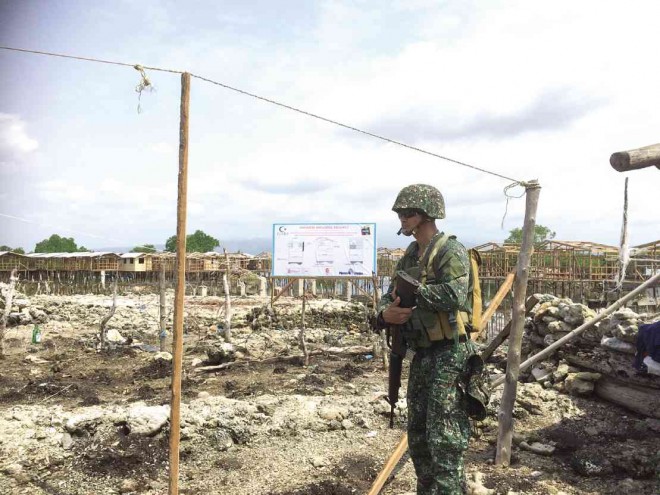3,000 Zamboanga families still homeless

A MARINE stands guard in the village of Talon-Talon on Sumariki Island, one of the areas that came under siege by followers of Nur Misuari in Zamboanga City in 2013. The place is now being rehabilitated with permanent homes being built on stilts. JULIE S. ALIPALA/INQUIRER MINDANAO
ZAMBOANGA CITY—Exactly two years after followers of Moro National Liberation Front (MNLF) leader Nur Misuari laid siege to the city, forcing thousands of families to leave their homes, the government has yet to complete a closure to the tragedy.
Over 3,000 of the families who lost their homes during the monthlong rampage that resulted in the deaths of some 200 people are still staying in 12 “transitory” sites, said Zenaida Arevalo, director of the Department of Social Welfare and Development in Western Mindanao.
Arevalo could not explain why the families had not yet moved into permanent shelters. “Better ask officials of the National Housing Authority (NHA) because it is the one constructing the permanent houses,” she suggested.
Reynaldo Bolay-og, an NHA supervising engineer, acknowleged that the construction of some permanent housing units had yet to start in some areas, including Rio Hondo village. But he said some 8,000 units currently being built could be completed by year’s end.
Nearly 200 people, including civilians, were killed and 120,000 abandoned their homes in Barangays Santa Catalina, Santa Barbara, Rio Hondo, Mariki, Kasanyangan, Mampang and Talon-Talon, when government forces fought MNLF rebels during the monthlong rampage that began on Sept. 9, 2013.
At the evacuation centers, more than 260 children and women died from various illnesses.
The government is pursuing the cases against 247 people who were arrested and jailed in Camp Bagong Diwa in Taguig on suspicion of involvement in the siege.
Mayor Ma. Isabelle Climaco-Salazar said some quarters were trying to influence the city government into accepting plea bargaining for the crimes of rebellion and violation of the international humanitarian law. “We said it with finality that we will not undertake any plea bargaining, so we will push through with the cases,” she said.
Lt. Gen. Rustico Guerrero, head of the military’s Western Mindanao Command, said soldiers continued to run after the prime movers of the siege, including Misuari, who was reportedly hiding in the hinterlands of Sulu.
Building their own houses
Some of those remaining in the transitory sites could not wait for their permanent relocation any longer. Ramada Jose, a cluster head for the “internally displaced persons” (IDPs), said those who were able to raise money on their own had built their own houses.
One evacuee, Abdel Abdulla, said the situation in the transitory sites was no different from that at the sports complex where they had stayed for months. “We still don’t have water and electricity and we still get wet when it rains,” he said.
Rodrigo Pagotaisidro, the city housing and land management division officer, said the conditions were not as serious as before, though. He said six areas with permanent housing units had already been occupied.
“Members of the homeowners association in Paniran, Martha, St. Peter, portions of Mariki, Lustre and Islamic village in Sta. Barbara had already moved into their permanent shelters and we expected more families moving out of the transitory sites very soon,” Pagotaisidro said.
Salazar also said life was gradually getting better for the IDPs.
So far, she said, 30 percent of the families displaced during the siege had already been provided permanent homes and the remaining number could resettle in their new houses in the next few months.
Salazar said the problem with some permanent houses was the lack of sanitation facilities. “There are permanent houses that are made available but the city cannot just accept them unless sanitation facilities were built,” she said.
City health officer Rodelin Agbulos recounted that his office had to deal with 20 to 24 deaths a month because the situation at the evacuation centers had worsened the conditions of those already ill.
Deaths still reported
There are still deaths being reported at the transitory sites, but Agbulos said unsanitary practices among the evacuees could be blamed for the prevalence of diseases.
“It has nothing to do with overcrowding anymore. It’s more of the way how they practice hygiene and sanitation,” he said, adding that the deaths were caused by acute gastroenteritis, diarrhea, pulmonary tuberculosis, asthma and diabetes.
Salazar acknowledged that it may take more time before “real healing, recovery and justice” would be achieved.
As for Ramada and other IDPs, the question remains: When exactly can they move into their new homes? Officials, like Salazar, could not provide a definite date.














